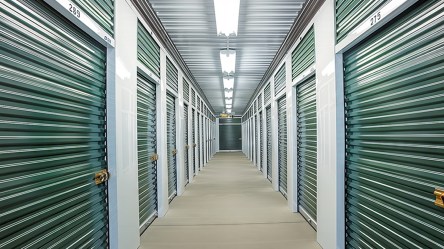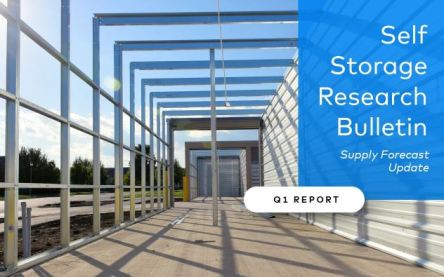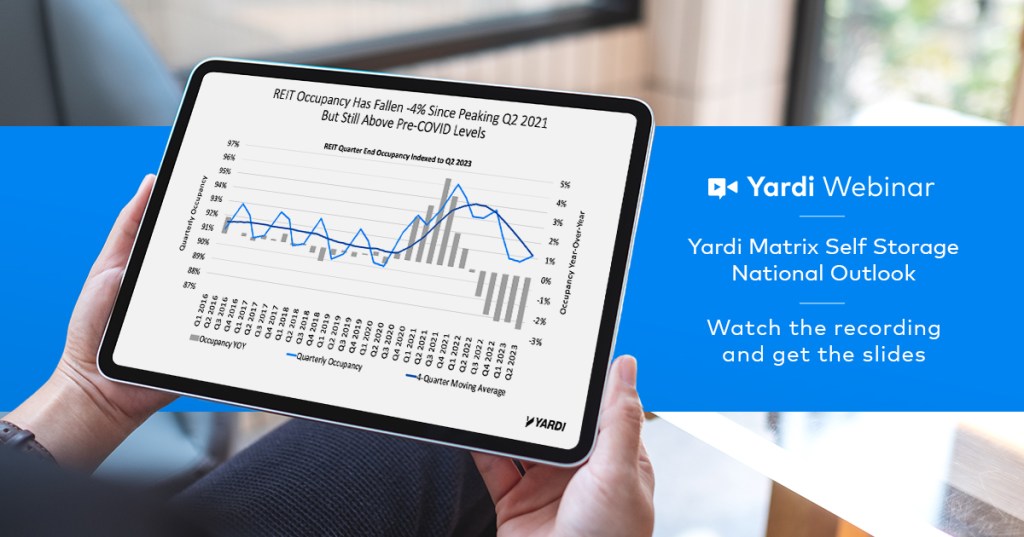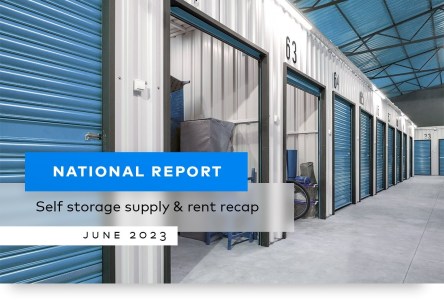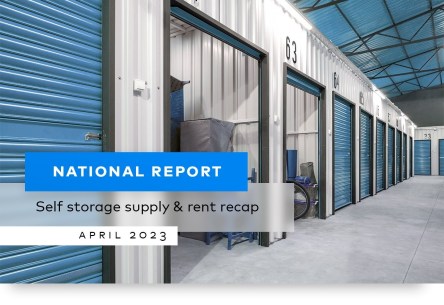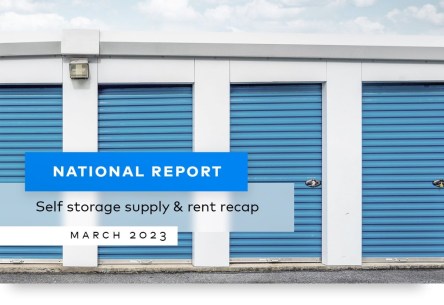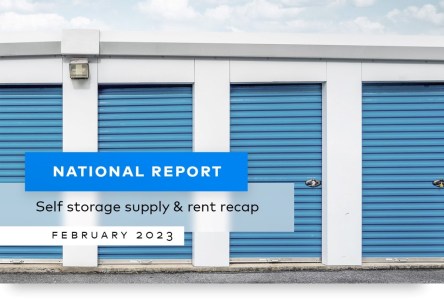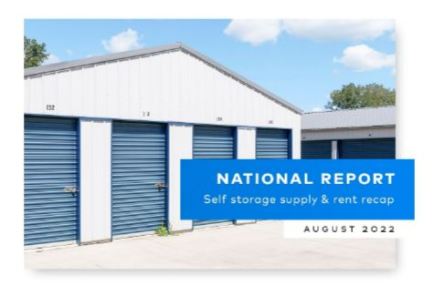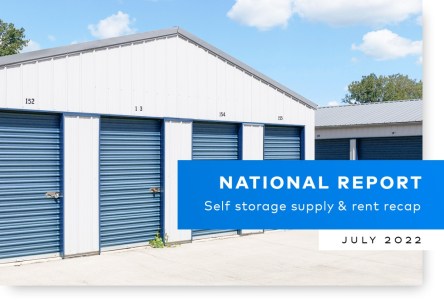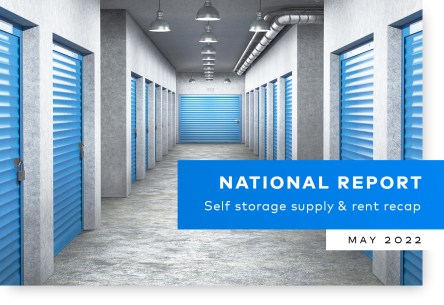The U.S. self storage industry’s dynamic landscape was the focus of a recent Yardi Matrix self storage industry update by Jeff Adler, vice president, and Tyson Huebner, director of research. The sector is emerging from two challenging years of declining rent, occupancy and revenue stemming from weak housing demand. But signs indicate that some supply and occupancy conditions are bottoming out. For example, although self storage transactions declined last year compared with 2023, activity in the second half of 2024 outpaced the same period in 2023 by 50%, generating momentum that is going to carry into 2025. “There’s a lot of capital out there available for self storage, and some large funds have been raised.” Meanwhile, year-over-year advertised rent rates improved from -4.2% in June 2024 to -1.2% in January. Real estate investment trusts involved in the sector have experienced pressures from increased property taxes, insurance and marketing costs. “Most of these companies believe that occupancy is bottoming out, or is at least stabilizing, which should give them more pricing power in 2025,” Huebner said. Absorption of supply faces resistance from demographic factors such as population growth, which measured 0.4% in 2024, down from about 1% at the turn of the century, and an anticipated reduced level of immigration. The U.S. Census Bureau and the Congressional Budget Office both project a continued drop in population growth, which will create “less demand for storage over the next few decades than in decades past,” Huebner said. “Many of the markets that have struggled the most with new supply in the past year will continue to struggle as their inventory grows. These are the same markets that rely on migration and population growth to absorb that new supply,” he added. Reasons for both concern & optimism Only...
New At SSA Spring 2025...
Storage innovations from Yardi
It’s almost time for the Self Storage Association (SSA) to host SSA Spring 2025, their biggest annual event on the East Coast. This year, Yardi is a sponsor, presenter and exhibitor — and our experts have a lot to show attendees. This is a rare opportunity on a national stage for the self storage industry to network, explore the latest tech and discover new ways to connect with customers. For those who haven’t been to an SSA event in a while, the 2025 Spring Conference & Trade Show is a great year to jump back in. For one, as an Ambassador Sponsor, it’s our job to help make the trip worth the while. We’re going to showcase our innovative facility marketing, management and market research solutions built just for the self storage industry. What Yardi offers Jeff Bailey, regional manager at Yardi, will host a roundtable to guide attendees through the process of streamlining business operations with a single connected solution. Join him on March 13 from 2:45-4 p.m. EDT. Our team will be at SSA Spring 2025 to demo and discuss four solutions attendees need to see: Yardi Storage Manager: Our leading-edge cloud-based platform for institutional self storage operators. A suite of optional add-on modules expands the functionality of the system to include advanced marketing, stored goods protection, procurement, construction, forecasting, investment management and more. Yardi Breeze Premier: Our all-in-one platform that is ideal for small- to mid-sized self storage businesses. Everything one would need for facility marketing, leasing, operations and accounting comes in one highly affordable package. Yardi Matrix: Real estate’s leading marketing intelligence tool for property-level data on over 38,000 facilities nationwide. StorageCafe: The self storage industry’s leading ILS for streamlined lead-to lease marketing tools that help find customers faster. Stop...
Self Storage May Struggle
As Fewer Americans Move
The latest Yardi Matrix Self Storage webinar provided insights into the current state of the economy and its impact on the self-storage industry. Find a full recording of the March 6 webinar here and view the presentation deck here. The self storage sector began seeing weaker performance in 2023 due to a decline in demand, primarily caused by low home sales (due to high interest rates) and subsequent reduced mobility nationwide. There has been a 25 percent reduction in state-to-state migration compared to 2021 and 2022. Consequentially, self storage revenue growth was nearly flat last year, driven by declining occupancy and decelerating street rent growth. Find the most recent monthly report on the self storage sector from Yardi Matrix. A near term expansion in self storage supply is forecast, while the coming years are expected to show an overall inventory decrease. Jeff Adler, vice president of Yardi Matrix, mentioned new rental strategies employed by REITS that keep street rents low and quickly moving vacant spaces, impacting same-store rent growth negatively. Despite construction and completions remaining steady, same-store rent growth was -3 percent in January. Adler discussed the current state of the market, highlighting that occupancy and rent increases during the pandemic pushed same-store sales revenues up by 37 percent. However, same-store occupancies have now declined to pre-COVID levels, hovering around 90 percent, and the decline in street rents is affecting overall revenues. Matrix analysts believe that that the sector may not see a significant performance improvement until home sales recover, expected in late 2024 or early 2025. “I think an improvement really doesn’t happen until home sales happen, which means the for-sale market opens up and that means (lower) interest rates, and that’s later in 2024, maybe early 25,” Adler said. However, potential opportunities in self storage are not unheard of. Locations where supply pressures were putting downward pressure on street rents, such as Orlando, Tampa, and Atlanta. Markets that experienced declining supply over the past few years, like New York, Denver, and Minneapolis, are considered to be on the mend. “These are places that really were hit hard a few years ago. But supply is waning. So they’re the first to kind of bounce, and I would say there are opportunities for stressed or distressed properties, you know, acquired in 2021 and 22 or developed in 2023,” Adler said. Gain more insight on the state of the economy as a whole and projections for the housing market by listening to the webinar...
Self Storage
Anticipates more supply
Yardi Matrix’s Q1 2024 Self Storage Supply Forecast suggests an expansion in near-term supply, while the coming years will show a decrease. The last quarter of 2023 registered an increase in construction starts and the under-construction pipeline, influenced by an uptick in new development. Consequently, the near-term forecast for 2024 and 2025 has been upped by 10.9 percent and 12.5 percent, respectively. Meanwhile, the forecast completions for the years 2026 through 2029 have been reduced in the latest update. Supply growth for 2026 and 2027 is expected to be around two percent of stock representing some 38 million NRSF. “In the second half of 2023 the number of abandoned and deferred projects in our database has noticeably increased, growth in both the planned and prospective pipelines has stalled and the year-over-year change in street rates was negative in 2023,” say Matrix analysts. In the fourth quarter of 2023, the planned pipeline rose by 1.43 percent, while the prospective stage remained flat throughout the year. The number of deferred projects grew 44.5 percent on an annual basis and the number of abandoned storage properties increased 104.2 percent compared to 2022. Review the new Self Storage Supply Forecast from Yardi Matrix. Yardi Matrix offers the industry’s most comprehensive market intelligence tool for investment professionals, equity investors, lenders and property managers who underwrite and manage investments in commercial real estate. Yardi Matrix covers multifamily, student housing, vacant land, industrial, office, retail and self storage property types. Email [email protected], call 480-663-1149 or visit yardimatrix.com to learn...
Weak Demand Hurts Self Storage
Yardi Matrix webinar recap
Self storage performance slumped in the second quarter of 2023, typically the strongest quarter, due to weak demand. That was among the top takeaways from a Thursday webinar hosted by industry leading data provider Yardi Matrix. You can view the webinar recording and presentation materials here. Among other key takeaways for the sector: Street rate growth continues to decelerate, as same store rates were down -4.6 percent in July One bright spot: operators were able to grow revenue by increasing existing customer rents (ECRI) The amount of new supply under construction Is moderating and likely won’t return to normal until 2025-2027 Investment activity is drastically reduced, with two notable exceptions (read on for details) “We’re in a kind of a 2017-2019 kind of world, where revenue growth is really off the back of ECRIs versus street rents,” said Jeff Adler, vice president of Yardi Matrix, during the webinar. Reasons that demand has dropped included the challenging single family real estate market, with interest rates for new purchases around 7 percent, and diminished mobility of American households post-pandemic. “Lower street rates are a result of weak move-in activity, with average REIT occupancy in Q2 2023 down 400 basis points from its all-time peak in Q2 2021,” states the latest self storage report. In July, overall national street rates (all unit sizes and types combined) dropped $1 to $141, down 0.7 percent month-over-month. Historically, rate growth is positive in July, averaging a sequential increase of 0.8 percent in the past seven years. While an anticipated recession has yet to fully materialize, Adler still expects that one will be in place by the end of the year, due to a lag time between Federal Reserve actions and the ultimate impact on the real economy. “We’re still in this period of time where you’re seeing strong economic growth, but we are seeing the beginning of the signs of a slowing trend,” Adler said. Self storage demand has historically been resilient, coming from a variety of sources, and growth rebounds quickly following a downturn due to month-to-month lease terms and flexible customer rate increase programs. But investor increased in the sector has also taken a hit in 2023, with two notable exceptions. Extra Space merged with competitor Life Storage in July. The combined company is now the largest storage operator in the country (based on the number of self-storage locations) with over 3,500 locations, approximately 270 million square feet of rentable storage space, and more than two million customers. Public Storage also announced last month that it has entered an agreement to acquire Simply Self Storage for $2.2 billion. According to the announcement: “The portfolio comprises 127 wholly-owned properties and 9 million net rentable square feet that are geographically diversified across 18 states and located in markets with population growth that has been approximately double the national average since 2018.” Aside from those significant moves, sales and M&A activity have plummeted, said Tyson Huebner, director of institutional research for Yardi Matrix. “It should be no surprise that transaction volume thus far this year has really fallen off the cliff. The number of properties sold in the first half of 2023, which doesn’t include those two portfolios, was down 56.6% from the first half of 2022,” Huebner said. Gain additional insights on self storage and the economy by checking out the entire...
Storage Rates Hold
Yardi Matrix Report
Self storage street rates were solid in May, with several unit types and sizes improving on a monthly basis and sequential growth staying to trend, according to the latest National Self Storage Report from Yardi Matrix. The self storage market continues to be resilient, despite headwinds to demand caused by a slowing housing market. National street rates for standard-size 10×10 non-climate-controlled (NON CC) units and 10×10 climate-controlled (CC) units both increased $1 month-over-month in May, to $128 and $143, respectively. Across all rate types tracked by Yardi Matrix, smaller-size units performed the strongest in May, as national rates for 5×5 units increased 1.8 percent for NON CC units and 1.7 percent for CC units on a monthly basis. Year-over-year, national street rates for 10×10 NON CC units decreased 3.8 percent, while rates for 10×10 CC units fell by 4.7 percent. Although year-over-year street rate growth has turned negative, net operating income continues to increase as operators push rates. That has come at the cost of a slight hit to occupancy rates, but demand is still above pre-pandemic levels. “The outlook for the sector remains optimistic, although concerns persist about how the slowdown in home sales and potential weakening job market caused by higher interest rates will impact storage demand, street rates and occupancy levels in the second half of 2023,” state Matrix experts. Learn more about the state of the self storage sector nationwide. Yardi Matrix tracks a total of 4,799 self storage properties nationwide in various stages of development — including 807 under construction, 1,959 planned and 646 prospective properties. Matrix also maintains operational profiles for 29,744 completed self storage facilities across the United States, bringing the total data set to 34,543. Yardi Matrix offers the industry’s most comprehensive market intelligence tool for investment...
Self Storage Rents
Still negative on annual basis
Self storage street rates continue to fall off of last year’s historic highs each month, according to the latest National Self Storage Report from Yardi® Matrix. However, sector fundamentals remain strong. Year-over-year street rate growth was negative in March for the sixth straight month, with national average rates for standard-size 10×10 units down 2.3 percent year-over-year for non-climate-controlled (NON CC) units at $127 and 3.4 percent for climate-controlled (CC) units at $142. “Although street rates are negative on an annual basis, rates remain relatively steady sequentially, with some unit types and sizes registering increases on a month-over-month basis,” say Matrix analysts. “Operators largely remain optimistic about demand despite the volatility in the financial markets because storage performance has repeatedly proven to be stable during times of economic volatility.” Most of Yardi Matrix’s top 31 metros recorded negative street rate growth last month compared to March 2022. Year-over-year, rates for 10×10 NON CC units were again negative in the majority of the top metros, with 25 experiencing decreases. Nashville was the only metro with positive YOY rate growth in March for both 10×10 NON CC and CC units, and the only city tracked without a drop in rates for CC units. Learn more about the state of the self storage sector nationwide. Yardi Matrix tracks a total of 4,735 self storage properties nationwide in various stages of development — including 817 under construction, 1,896 planned and 656 prospective properties. Matrix also maintains operational profiles for 29,299 completed self storage facilities across the United States, bringing the total data set to 34,034. Yardi Matrix offers the industry’s most comprehensive market intelligence tool for investment professionals, equity investors, lenders and property managers who underwrite and manage investments in commercial real estate. Yardi Matrix covers multifamily, student housing, industrial,...
Storage Stabilizes
Yardi Matrix Market Report
Self storage street rates were flat in February as consumer relocation trends and demand revert to pre-pandemic levels, according to the latest National Self Storage Report from Yardi Matrix. Growth of the average national street rate for all unit sizes was -2.8 percent year-over-year, unchanged from January. Rates for standard-size 10×10 units fell by 3.1 percent year-over-year for non-climate-controlled (NON CC) units and 4.1 percent for climate-controlled (CC) units. Despite lack of rate growth, the industry is in a comfortable position as the typically busy spring leasing season approaches. “Although fundamentals softened slightly in the fourth quarter owing to normal seasonal patterns and some customers balking at increasing rates, demand is strong and occupancy remains ahead of where it normally is this time of year,” states the report. “We’re seeing good demand from new customers coming into the system,” Public Storage’s chief financial officer, Tom Boyle, said recently. “Move-in volumes through the (winter) are up double digits.” Self storage-foused REITs are forecasting mid-single digit net operating income growth in 2023. Annual street rate growth continued to be negative for most of the top 31 metros in February. Only three of the top 31 Matrix self storage metros had a year-over-year increase in street rates for 10×10 NON CC units, while rates were negative in 25 of the top metros. Learn more about the state of the self storage sector nationwide. Yardi Matrix tracks a total of 4,730 self storage properties nationwide in various stages of development — including 823 under construction, 1,885 planned and 662 prospective properties. Matrix also maintains operational profiles for 29,221 completed self storage facilities across the United States, bringing the total data set to 33,951. Yardi Matrix offers the industry’s most comprehensive market intelligence tool for investment professionals, equity investors, lenders...
Demand Steady
For Self Storage
Continuing steady demand signals stability for the U.S. self storage sector even as street rates declined in January, according to the February 2023 National Self Storage Report from Yardi Matrix. Year-over-year street rates for 10X10 non-climate-controlled units slid by $7 to $126 in January, a 2.3% drop from their peak of $133 in the summer of 2022. Only five of the top 31 metros tracked by Matrix recorded rate growth in January. Despite this typical seasonal slowdown, “average street rates [for climate-controlled and non-climate-controlled units] remain healthy compared to historical levels,” the report says. The new-supply pipeline increased by 10 basis points month-over-month in January, accounting for 3.7% of completed inventory. In 2022, the number of households using self storage reached 14.5 million, an increase of about 970,000 since 2020. “As a result of the record demand, the self storage sector appears to be well-positioned to withstand potential economic headwinds in 2023,” according to the report. Get the latest on self storage supply, rent trends and more in the new Yardi Matrix report. Get even more details in a webinar on March 1. Yardi Matrix tracks 4,626 self storage properties nationwide in various stages of development. Matrix also maintains operational profiles for 29,072 completed self storage facilities, bringing the total data set to 33,698. Yardi Matrix offers the industry’s most comprehensive market intelligence tool for investment professionals, equity investors, lenders and property managers who underwrite and manage investments in commercial real estate. Yardi Matrix covers multifamily, student housing, industrial, office and self storage property types. Email [email protected], call 480-663-1149 or visit yardimatrix.com to learn...
Self Storage Update
From Yardi Matrix
National self storage street rates hit their lowest average of the year last month, according to the latest National Self Storage Report from Yardi Matrix. Average street rates for both 10X10 climate controlled (CC) and 10X10 non-climate controlled (NON-CC) units slipped in October for the second straight month as demand weakened. The national average rate in October was $145, the lowest in 2022 so far. The figure is a 0.7 percent decrease year-over-year (YOY). “Home sales, a major driver of storage demand, have slowed sharply in recent months as rising mortgage rates have made homebuying less affordable,” states the report. “What’s more, as inflation persists and a recession is increasingly likely, households are cutting expenditures on non-essential items such as storage.” Many operators are reducing street rates to maintain high levels of occupancy and looking for ways to cut costs in the event of an anticipated recession. Some operators are moving to remote facility management to reduce site staff and cut operating costs. For NON-CC units, only one of the top 31 Matrix-tracked metros had an annual street rate increase greater than five percent in October, while rates decreased in 11 of the top metros. For CC units, just one of the top 31 had five percent or more growth, while 21 metros registered negative rate growth YOY. Learn more about the state of the self storage market nationwide. Yardi Matrix tracks a total of 4,458 self storage properties nationwide in various stages of development — including 1,711 planned, 800 under construction and 604 prospective properties. Matrix also maintains operational profiles for 28,847 completed self storage facilities across the United States, bringing the total data set to 33,305. Yardi Matrix offers the industry’s most comprehensive market intelligence tool for investment professionals, equity investors, lenders and...
Rates Slow
For Self Storage
Average self storage street rates reduced slightly in August, according to the latest National Self Storage Report from Yardi Matrix. A national average overall street rate of $149 was recorded. Despite moderating street rate performance, demand continues to be strong. The new self storage report focuses on areas of demand for storage units, which include apartment renters and Gen X (late 30s to 50s) customers. “Gen Xers are among the biggest users of storage, with 44 percent reporting use of storage units and 21 percent planning to use it in the near future. But even as an increasing number of households use self storage, we expect to see further moderation of street rates the rest of this year,” states the report. Storage owners remain focused on growing rents of existing customers, relying on demand for the service that grew significantly in 2021. Secondary markets experiencing rapid population growth continue to lead in street rate gains. For 10×10 non-climate-controlled (NON CC) units, eight of the top 31 metros had street rate increases greater than five percent in August, while rates decreased in seven metros. Year-over-year street rate growth continues to decelerate. Nationwide, the overall average street rate, which includes all unit sizes and types, grew 1.4 percent year-over-year in August, a 130-basis-point drop from July’s annual growth rate and a 280-basis-point drop from the rate in June. Learn more about the state of the self storage market nationwide. Yardi Matrix tracks a total of 4,203 self storage properties nationwide in various stages of development — including 1,594 planned, 760 under construction and 515 prospective properties. Matrix also maintains operational profiles for 28,719 completed self storage facilities across the United States, bringing the total data set to 32,922. Yardi Matrix offers the industry’s most comprehensive market intelligence...
Storage Stays Steady
Rents Remain at Historic Highs
Demand for self storage units is steady, so street rates remained at record highs last month, according to the latest National Self Storage Report from Yardi Matrix. Average U.S. street rates for 10X10 non-climate-controlled (NON CC) units remained at $132 in June, matching the all-time high set last month. Climate controlled (CC) 10×10 units were an average of $151, also an all time high. The latest rates signal an expected slowdown in growth. Nationwide, the overall average street rate, which includes all unit sizes and types, grew 2.1 percent year-over-year in July, a 210-basis-point drop compared to June’s annual rate growth. “With strong demand and street rates at all-time highs, storage operators have more opportunity to increase rents for existing customers and replace rate-sensitive existing customers with new customers at the elevated street rates,” say Matrix analysts. During recent second-quarter earnings calls, several REIT executives said they expect seasonality to return in 2022’s second half after several quarters of unusually low move-outs. The number of customers moving out is likely to normalize later this year. While street rates are shrinking in some areas of the country, growth remains the healthiest in the Southeast. For 10×10 NON CC units, nine of the top 31 metros had street rate increases greater than five percent in July, while rates decreased in four. For 10×10 CC units, only two of the top 31 had five percent or more growth, while eight experienced negative growth. Learn more about the state of the self storage market nationwide and sign up for an Aug. 31 webinar on the vertical, where Matrix experts will go in-depth on storage trends and the economy overall. Yardi Matrix tracks a total of 4,156 self storage properties nationwide in various stages of development — including 1,555...
Self Storage is Solid...
Yardi Matrix update
Self storage rates keep edging up month after month due to persistent demand, according to the latest National Self Storage Report from Yardi® Matrix. Average U.S. street rates for 10X10 climate-controlled (CC) units rose $1 to $132 in June, while average rates for 10X10 non-climate-controlled (NON CC) units also rose $1 to $150, both all-time highs. “Demand continues to come from all directions, including the growth in home offices as most companies employ some type of hybrid strategy for knowledge workers, consumer spending on items such as clothing and furniture, and to a lesser degree businesses using storage for distribution purposes,” say Matrix analysts. Solid occupancy rates also enable property managers to push in-place rents, calculating that vacant units can be filled by new customers at higher rates. Nationally, the overall average street rate for all unit types increased 3.5 percent year-over-year in June. Although rates are at record highs, the growth rate has declined steadily since peaking at 14.4 percent in June 2021. However, market performance remains comfortably above historical trends. Concerns for the sector center around the slowing economy and rising interest rates that have produced a reduction in home sales, which drives storage demand. Storage facilities under construction or planned rose to 10 percent of existing stock this month. Strong fundamentals serve to incentivize development of new supply, but there is some concern that fear of oversupply may arise in highly penetrated markets. Yardi Matrix tracks a total of 4,115 self storage properties nationwide in various stages of development — including 1,524 planned, 755 under construction and 516 prospective properties. Matrix also maintains operational profiles for 28,455 completed self storage facilities across the United States, bringing the total data set to 32,570. Learn more about the state of the self storage...
Self Storage Insights...
With Corey Rothgeb
Corey Rothgeb is the senior staff accountant for Self Storage Plus, an independent business that generates $3.6 million in annual revenue. We talked with him about what it takes to succeed in the storage industry, how he addresses industry challenges and the ways Yardi Voyager saves Self Storage Plus enormous amounts of time and energy. Tell us a little about yourself. What’s your background, and how long have you been in property management?I’ve been with Self Storage Plus since August of 2020. Prior to that I lived in San Diego, California. I studied at the University of California San Diego and received my bachelor’s in economics in 2019. I got my foot in the door in property management with a publicly traded REIT in San Diego. That’s where I practiced on property management software. I worked there for about nine months as an accounts payable clerk and financial administrator working on budgets. Then I made the move to the East Coast in August of 2020 and started as a staff accountant at Self Storage Plus. I’ve since progressed from staff accountant to senior staff accountant and currently hope to progress to controller. There have been opportunities to grow tremendously in property management, and I love the whole real estate industry in general. What challenges does property management software solve for your business?Voyager helps with reporting on our end. I think the biggest challenge we faced when the company switched to Voyager in 2020 was just having processes in place, and Yardi really helped provide structure for those. The invoicing and reporting automation in general provided a kickstart to getting all of our processes in place. What features in Voyager are helping you solve those challenges?The ability to run and automate specific reports. In fact,...
Self Storage Update
Sector demand continues
Self storage continues to perform well nationwide according to the latest National Self Storage Report from Yardi® Matrix. National average storage rates rose $1 to $146 in April, matching the all-time high set last fall. Street rate growth, however, is decelerating because rates increased more dramatically in 2021. Street rates for 10×10 non climate-controlled units nationally increased 4.8 percent year-over-year in April, while rates for 10×10 climate-controlled units saw slightly less growth at 4.3 percent. According to industry executives at the NYSSA investment forum this month, demand comes not only from normal factors like migration and student movement, but also from individuals who need storage to accommodate offices and businesses that have been squeezed out of the tight commercial market. Storage customers are renewing at high rates and extending the length of stays. It all results in growth in rents and net operating income, which has increased upwards of 20 percent for some REITs over the past year. However, market headwinds do exist. Consumer demand that has driven the recent boom could cool as higher interest rates slow migration and dampen home sales, which are major drivers for self storage. And although storage has a limited amount of capital expenditures, increasing expenses for items such as labor and materials may erode benefits of strong rent growth. “Storage executives, however, are confident the segment is uniquely well positioned in an inflationary environment because leases can keep pace with rising prices and they foresee an ongoing increase in demand,” states the report. Yardi Matrix tracks a total of 4,051 self storage properties nationwide in various stages of development — including 1,467 planned, 747 under construction and 526 prospective properties. Matrix also maintains operational profiles for 28,289 completed self storage facilities across the United States, bringing the...

